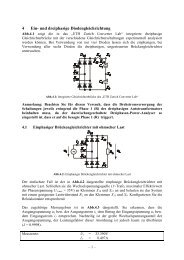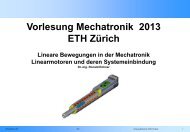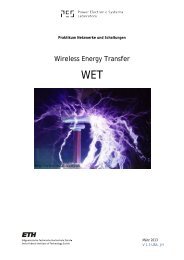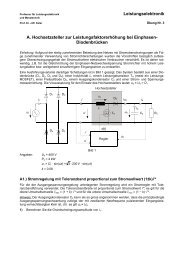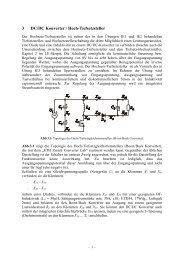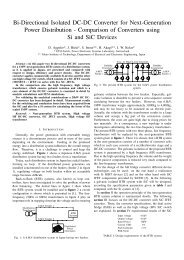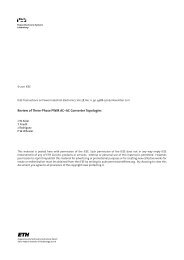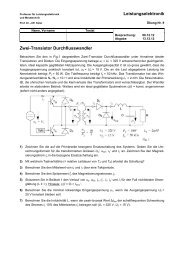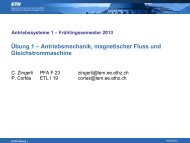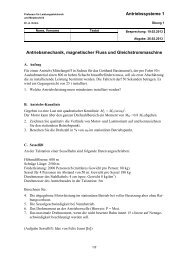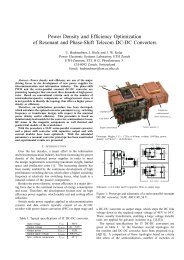U - Power Electronics Systems Laboratory
U - Power Electronics Systems Laboratory
U - Power Electronics Systems Laboratory
Create successful ePaper yourself
Turn your PDF publications into a flip-book with our unique Google optimized e-Paper software.
<strong>Power</strong> Electronic <strong>Systems</strong> <strong>Laboratory</strong> <strong>Power</strong> Electronic <strong>Systems</strong> 1<br />
Prof. Dr. J.W. Kolar Exercise No. 6<br />
Last Name, First Name<br />
Passed<br />
Resonant Converter II<br />
Diagram 1 shows a circuit for the inductive heating of metals with the specifications shown below. The<br />
circuit has no load, i.e. there is no item in inductor L, and operates with f = 100 kHz and a duty cycle of<br />
50%, i.e. 50% of the time is T + and 50% T - activated.<br />
Disregard the damping resulting from the parasitic ohmic resistances. Furthermore, assume that the<br />
transformer, the power transistors and the diodes are operating ideally in your calculations.<br />
i DC<br />
U DC<br />
T +<br />
C DC<br />
T -<br />
D +<br />
D -<br />
u<br />
C<br />
inductor<br />
u C<br />
i L<br />
L<br />
ideal transformer<br />
10:1<br />
Diagram 1 – Resonant Converter<br />
Specifications:<br />
Input voltage:<br />
U 1 = 540 V<br />
Inductor inductance: L = 0.57 µH<br />
Resonant circuit capacity<br />
C = 100 nF<br />
Transformation ratio of the transformer: n = 10:1<br />
You must answer questions 1-4 at least to pass the exercise.<br />
1) What are the average values of the capacitor voltage u C and the current i L ?<br />
Make a drawing of the waveform of the current i L and the capacitor voltage u C in the diagram below<br />
where u C (t=0) = 0 V and i L (t=0)= 0 A and the transistor T + is switched on at time zero for T/4 =<br />
1/(4f), i.e. a quarter cycle duration. In addition, indicate when which semiconductor is conducting<br />
current.<br />
2) Consider the fundamental component of the oscillation and the DC-part of the voltage u. Determine<br />
the fundamental component of the oscillation and the DC-part of the capacitor voltage u C and the<br />
current i L by use of the complex alternating current calculation and the superposition theorem. Add<br />
the fundamental oscillation trajectory to a u C -Zi L -diagram.
<strong>Power</strong> Electronic <strong>Systems</strong> <strong>Laboratory</strong> <strong>Power</strong> Electronic <strong>Systems</strong> 1<br />
Prof. Dr. J.W. Kolar Exercise No. 6<br />
3) Now make a u C -Zi L diagram for no-load (steady-state operation, scale: 90 V/cm) and f = 100 kHz<br />
for the circuit in diagram 1 (above) in the coordinate system below.<br />
How does the diagram change when the operating frequency is doubled to f = 200 kHz?<br />
4) Calculate the dependency of the RMS value of the current i L at no load from the operating<br />
frequency normalised to the resonance frequency of the resonant circuit f/f 0 (consider only the<br />
above resonant operation f/f 0 > 1).<br />
Note: Determine the peak value of i L as a function of the parameter f/f 0 , Z o (characteristic<br />
impedance of the resonant circuit) and U DC . As the current i L , according to question 1), is<br />
approximately triangularly shaped, the RMS value can be easily determined out of the<br />
peak value.<br />
5) Can the transistors (and anti-parallel diodes) used in the circuit be replaced by thyristors?<br />
Justify your answer on the basis of the waveforms determined in question 1).<br />
6) How can the optimal operating frequency f in relation to f 0 be selected regarding a power output to<br />
the load (an item in the inductor coil heated by the eddy currents) in order to keep the load on the<br />
inverter as small as possible?<br />
7) How large is the maximum stored energy in the resonant circuit in the case of above resonance<br />
and how can this be read from the u C -Zi L diagram in question 3).<br />
8) What does the u C -Zi L diagram for below-resonance operation (f = 50 kHz) look like?<br />
(Complete the diagram in the drawing after question 3)).
i / u / i<br />
L C DC<br />
Task 1)<br />
540V<br />
u<br />
T on +<br />
270V<br />
5µs<br />
10µs<br />
t<br />
T/2 = 1/(2f)<br />
i DC<br />
U DC<br />
T +<br />
C DC<br />
T -<br />
D +<br />
D -<br />
u<br />
C<br />
inductor<br />
u C<br />
i L<br />
L<br />
ideal transformer<br />
10:1
Task 3) and 8)<br />
Z*i L<br />
270V 540V 1080V<br />
540V<br />
u C<br />
-540V<br />
-540V<br />
i DC<br />
U DC<br />
T +<br />
C DC<br />
T -<br />
D +<br />
D -<br />
u<br />
C<br />
inductor<br />
u C<br />
i L<br />
L<br />
ideal transformer<br />
10:1



